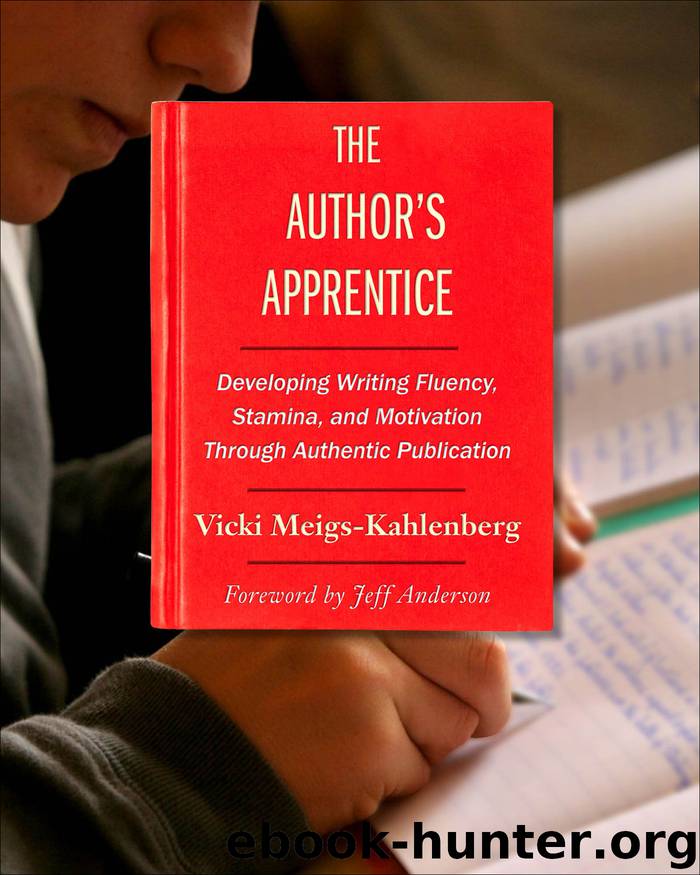The Author's Apprentice by Meigs-Kahlenberg Vicki;

Author:Meigs-Kahlenberg, Vicki;
Language: eng
Format: epub
Publisher: Stenhouse Publishers
Published: 2016-02-04T16:00:00+00:00
Figure 5.2 Students share some thoughts about writing a novel in a month.
Through NaNoWriMo, students are encouraged to express themselves and explore their stories without worrying about red correction marks. They build sentence fluency and writing confidence by going with the flow of their story and playing with words and phrases. Grant Faulkner, the executive director of NaNoWriMo, explained in an e-mail interview that, like many students, he did not have positive writing experiences in school. “I grew up in classrooms where writing was a punishment (writing “I will not chew gum” fifty times on the blackboard) or something that seemed easier to get wrong than right because I associated writing with red pencil marks.”
Faulkner says that the NaNoWriMo achievement for students is akin to completing a marathon, and it “breeds the type of academic confidence that crosses over into other academic subjects. Because they know they can accomplish such a task, a five-paragraph essay looks like a piece of cake, and when they’re daunted by their next research paper, they know they can just jump in and write a draft. The best writers, whether they’re writing business memos or scientific reports, know the joy of writing and understand how to critically play with words and put their visions and thoughts into language.”
The ripple effect doesn’t end there. Students develop an appreciation of the role that editing and revising play in good writing. This burst of confidence and newfound appreciation of the writing process is reflected in all kinds of writing for all audiences and purposes, including high-stakes testing.
A Note on Test Writing
Test writing is a territory unto itself. My students now know how to tackle writing-test anxiety, and they can easily overcome blank-page fear. And after writing a novel during NaNoWriMo, developing quantity and voice in their writing is no longer an issue. Students learn to use specific details, interesting leads and closings, and myriad craft techniques, and by the time the spring testing period rolls around, they’ve also learned from the authors the importance of context, revision, and editing. Getting kids to view testing as just another form of publication will go far in making positive results possible. After all, when they are under a deadline, they must produce their best work under a specific set of submission guidelines, and they are sending off their writing outside of the classroom. (That sounds a lot like publication to me!)
Download
This site does not store any files on its server. We only index and link to content provided by other sites. Please contact the content providers to delete copyright contents if any and email us, we'll remove relevant links or contents immediately.
The Art of Coaching Workbook by Elena Aguilar(50105)
Trainspotting by Irvine Welsh(21018)
Twilight of the Idols With the Antichrist and Ecce Homo by Friedrich Nietzsche(18297)
Fangirl by Rainbow Rowell(8785)
Periodization Training for Sports by Tudor Bompa(7916)
Change Your Questions, Change Your Life by Marilee Adams(7371)
This Is How You Lose Her by Junot Diaz(6434)
Asking the Right Questions: A Guide to Critical Thinking by M. Neil Browne & Stuart M. Keeley(5355)
Grit by Angela Duckworth(5295)
Red Sparrow by Jason Matthews(5195)
Paper Towns by Green John(4790)
Room 212 by Kate Stewart(4732)
Ken Follett - World without end by Ken Follett(4443)
The Sports Rules Book by Human Kinetics(4077)
Housekeeping by Marilynne Robinson(4059)
Double Down (Diary of a Wimpy Kid Book 11) by Jeff Kinney(3924)
Papillon (English) by Henri Charrière(3902)
Exercise Technique Manual for Resistance Training by National Strength & Conditioning Association(3785)
The Motorcycle Diaries by Ernesto Che Guevara(3782)
